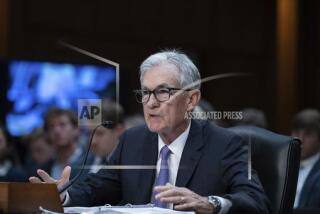Excerpts from current market commentary by analysts...
- Share via
Excerpts from current market commentary by analysts at major and regional brokerages, editors of investment newsletters and portfolio managers
John R. Williams, economist, Bankers Trust Co., New York
Investors got virtually every piece of reassuring news that they had been hoping for throughout last week, capped by a moderate October employment report. The U.S. economy clearly has geared down significantly from the brisk second-quarter tempo, eliminating the threat of monetary tightening for the rest of this year. Without lifting a finger, the Federal Reserve Board seems to have achieved yet another successful “soft landing” for the economy.
At this point, however, the bond market probably has pretty fully discounted a steady Fed policy for the rest of 1996. Any further rally, therefore, would likely require credible evidence that the economy has downshifted to a subpar pace that would ultimately lead to Fed easing. To the contrary, we remain sensitive to the possibility of inflationary pressures triggering monetary restraint as the economy picks up a bit more speed this year and into 1997. Inflationary strains lurk just below the surface, given still-stretched labor resources.
Greg Smith, chief strategist, Prudential Securities, New York
The key to the 1997 corporate earnings outlook is whether a series of interest-rate cuts in Europe can revive Western European economies. So far this year the U.S. economy has produced sufficient growth that companies, generally speaking, have been able to enjoy strong profits without help from global economic strength. Next year, they may not be so fortunate.
While it is not critical that we see signs of economic growth out of Europe in the current month or even between now and year-end, the time of reckoning is drawing near. If we do not see some signs of life before too long, my concern is that Europe will be viewed as having insurmountable structural impediments to growth. And at a time when the Far East economies continue to slow, a worsening European outlook could become a major issue for 1997 corporate profits--potentially sowing the seeds of investor disappointment. I do not believe that the stock market will have to shoulder this problem in 1996, but it could become a major investment theme as early as the first quarter of 1997.
Jay Schabacker, editor, Mutual Fund Investing newsletter, Potomac, Md.
Two events could suddenly derail the stock market’s bull run: First, rapidly rising inflation and interest rates. And second, the reelection of President Clinton with a Democratic sweep in both the Senate and the House. But I don’t expect either event to occur.
As we’ve already seen, rising inflation will be gradual this time around--most people will never know it’s here until it’s too late. Therefore, the stock market’s decline will most likely be gradual, not a sudden crash. Your best protection from rising inflation is still real estate funds, natural resources funds and gold funds.
Second, I believe Clinton will be reelected, but it’s a long shot that the Democrats will control Congress. This is bully for the stock market, which doesn’t like change. With a split-party government not too much gets done.
Charles M. LaLoggia, editor, Special Situation Report newsletter, Rochester, N.Y.
Right now, bearish sentiment on gold is just about as high as it has ever been on record, yet gold is still sitting [around] its first key support area, near $380 an ounce. Despite widespread negativity and disinterest in gold, and despite recent hysteria over whether the International Monetary Fund would sell some of its gold to help get money to poorer nations--despite all this, the big collapse in gold below the $370-$380 support zone has not taken place.
All of this strikes me as symptomatic of an important bottom in the price, not a top, and I think those who are salivating over a gold price collapse are going to be wrong. The only thing that would truly shake my faith would be a decline in the London gold price below $370, which is the real support zone of last resort. Barrick Gold, the undisputed bellwether of gold stocks, sits on what should be a rock-solid support zone between $24 and $26 a share. A close over $28 would be a key short-term buy signal for Barrick, and probably for the whole gold complex.
--Compiled by Times staff writer Tom Petruno
More to Read
Inside the business of entertainment
The Wide Shot brings you news, analysis and insights on everything from streaming wars to production — and what it all means for the future.
You may occasionally receive promotional content from the Los Angeles Times.










